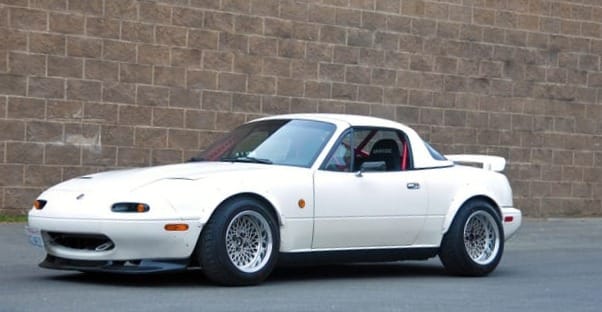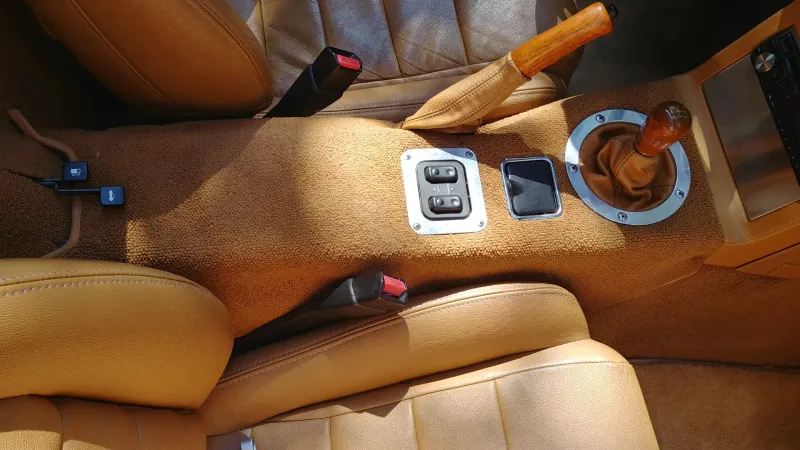Revive Your Miata’s Faded Paint (DIY Guide)
Revive your MX‑5’s paint from dull to dazzling with this step-by-step polishing and restoration guide.

Sun‑baked clear coat, chalky single‑stage, and swirl‑city panels don’t have to spell “respray.” With the right prep, a dual‑action polisher, and a bit of patience, you can bring a tired MX‑5 back to head‑turning gloss in just a couple of days. This guide walks you through every step, gear checklist to final seal, so you spend less time guessing and more time enjoying that freshly minted shine on your next back‑road blast.
Getting Started
Kick things off by rolling the car into a shaded spot where the temperature hovers between eighteen and twenty‑eight degrees Celsius and the humidity stays under sixty percent. Two bright 5 K work lights on stands will let you spot every swirl, and a handheld swirl‑finder is handy when you need to tilt the beam across metallic paint. If you own a paint‑thickness gauge, take a few readings now, older single‑stage NAs usually show 110 to 150 microns of total paint, while later clear‑coat Miatas sit closer to ninety to one‑hundred‑twenty microns with only about forty microns of actual clear. Suit up with nitrile gloves, safety glasses, ear plugs, and, if you’re working indoors, a half‑mask to dodge dust and solvent fumes. Your main weapon is a five‑inch random‑orbital polisher in the six‑hundred‑to‑six‑hundred‑eighty‑watt range, backed up by a stack of clean pads, three heavy‑cut, four medium, and four finishing pads are enough to keep you swapping before a pad overheats. Line up a heavy compound, a medium compound, and a jewelling polish, then cap the day with either a beginner‑friendly one‑year ceramic coat or a six‑month SiO₂ spray sealant.

Identify Your Paint System
Before you reach for a pad, work out which paint system you’re dealing with. A quick look at the build plate plus a bit of community lore tells you most solid‑color NA Miatas, think red, white, or black, left Hiroshima with single‑stage paint, whereas metallic NAs and every NB, NC, and ND have the more modern base‑coat plus clear‑coat. Still unsure? Rub a dab of glazing compound on an unseen corner: if the cotton pad comes away red, you’ve got single‑stage; if it shows only a yellowish tint, you’re looking at clear‑coat. That distinction shapes the whole game plan because single‑stage refreshes by sacrificing oxidised pigment, while clear‑coat refreshes by levelling scratches in the clear layer.
Decontamination
Start with a strip wash: mix roughly ninety millilitres of strong strip shampoo with nine hundred millilitres of water in a foam cannon, blanket the car, and let the suds soak for five minutes. Follow up with a two‑bucket contact wash, always rinsing your mitt before it touches a clean panel. With the surface rinsed, spray on an iron remover and watch for purple fallout for two to three minutes; hit the lower rockers with tar remover for another three. After the chemicals, glide a fine‑grade clay bar or synthetic towel across the paint using dedicated clay lube, no waxy quick‑detailers, because they clog polishing pads. Finish the prep with a twenty‑percent IPA wipe so the paint is squeaky‑clean and ready for correction.
Mask‑Up
Work a roll of automotive tape along every rubber seal, plastic trim edge, and soft‑top seam. On ND RFs, tape the aluminium roof seam because that section can measure under eighty microns and doesn’t like heavy polishing.

Test‑Spot
Pick a rough but representative fifty‑by‑fifty‑centimetre patch and start gentle: a medium foam pad plus medium compound at speed four on the DA, using firm but not brutal pressure for the first couple of passes before easing off. If that combo erases roughly two‑thirds of the swirls without haze, you’re golden. Only reach for a heavy‑cut pad and compound at speed five if deeper scratches still mock you. Once the defects are down to your comfort zone, swap to a soft finishing pad and a jewelling polish at speed three, feathering the pressure until the paint pops like wet candy.
Full‑Car Correction
With the winning combo locked in, move panel to panel. Prime a fresh pad with six to eight pea‑sized dots for its first outing, then add three or four dots for each new section. Work three overlapping vertical passes followed by three horizontal passes, covering a half‑metre square at a time and overlapping each stroke by fifty percent. Wipe the pad clean every couple of sections, and swap in a fresh one every time you finish an area about the size of the hood. On clear‑coat cars that show crows‑feet cracks or heavy orange‑peel, you can break out DA wet‑sanding discs, fifteen‑hundred, two‑thousand, then three‑thousand grit, on speed one or two, keeping total clear removal to under seven microns. After cutting, glide a soft open‑cell pad with a micro‑abrasive finishing polish over the entire car, usually two slow passes in each direction, until the surface is haze‑free and dripping with gloss.
Seal and Protect
If the car lives outside, level on a user‑friendly one‑year ceramic coating: work small sections, wait about a minute for the rainbow flash, then buff until the panel feels slick and clear. Leave the car untouched for twelve hours and avoid washing it for a week. If it sleeps in a garage, a quality SiO₂ spray sealant does the trick, mist half a panel, spread with one microfiber, and chase with a second towel until the finish is streak‑free.

First‑Day Care
Keep the freshly corrected Miata indoors for the first twenty‑four hours or slip a breathable cover over it. Use a low‑pressure quick‑detailer and a suede applicator to knock down any high spots within the first sixty minutes if you chose the ceramic route, and jot down all those thickness‑gauge readings for next year’s check‑up.
Maintenance
A gentle pH‑neutral wash every week keeps grime at bay. Single‑stage cars love a monthly hit of spray carnauba wax to replenish pigment oils, while clear‑coat cars prefer an SiO₂ topper as a drying aid. At the six‑month mark, inspect the finish: single‑stage owners might run a quick pass with a finishing pad if chalk returns, and clear‑coat owners can simply re‑seal unless swirls reappear. Plan on another light polish of clear‑coat cars every twelve to eighteen months, always keeping total clear thickness above eighty microns.
Troubleshooting + More Tips
If a pad cakes up with white powder after just one panel on a single‑stage NA, that’s dead pigment, clean the pad with all‑purpose cleaner and rotate pads sooner. Should the pad skip or stick, you’ve probably overloaded it or the panel is too warm; back off on product and give the pad a quick water mist. Holograms usually mean you stayed too aggressive for too long, so follow up with a softer pad and finishing polish. Streaky sealant nearly always means the panel was hot or you used too much, rewipe with a slightly damp towel and re‑apply ultra‑thin.
Know your paint and measure it before you grind away precious microns. Dial in a perfect test spot and repeat that process consistently across the car; brute force is never the answer on thin Mazda paint. Finally, lock in your hard work with a ceramic or SiO₂ sealant the very same day, because freshly exposed pigment or clear has zero UV defence until you give it a shield. Master these fundamentals and you can take a chalky, sun‑baked roadster from tired to showroom‑fresh in a single weekend, no respray required, just a bit of sweat and a lot of satisfaction.




